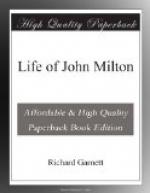“in
Adam wrought
Commiseration;...
As one disarmed, his anger
all he lost,
And thus with peaceful words
upraised her soon.”
Phillips appears to intimate that the penitent’s reception began like Dalila’s and ended like Eve’s. “He might probably at first make some show of aversion and rejection; but partly his own generous nature, more inclinable to reconciliation than to perseverance in anger and revenge, and partly the strong intercession of friends on both sides, soon brought him to an act of oblivion, and a firm league of peace for the future.” With a man of his magnanimous temper, conscious no doubt that he had himself been far from blameless, such a result was to be expected. But it was certainly well that he had made no deeper impression than he seems to have done upon “the handsome and witty gentlewoman.” One would like to know whether she and Mistress Milton ever met, and what they said to and thought of each other. For the present, Mary Milton dwelt with Christopher’s mother-in-law, and about September joined her husband in the more commodious house in the Barbican whither he was migrating at the time of the reconciliation. It stood till 1864, when it was destroyed by a railway company.
Soon after removing to the Barbican, Milton set his Muse’s house in order, by publishing such poems, English and Latin, as he deemed worthy of presentation. It is a remarkable proof both of his habitual cunctativeness and his dependence on the suggestions of others, that he should so long have allowed such pieces to remain uncollected, and should only have collected them at all at the solicitation of the publisher, Humphrey Moseley. The transaction is most honourable to the latter. “It is not any private respect of gain,” he affirms; “for the slightest pamphlet is nowadays more vendible than the works of learnedest men, but it is the love I bear to our own language.... I know not thy palate, how it relishes such dainties, nor how harmonious thy soul is: perhaps more trivial airs may please better.... Let the event guide itself which way it will, I shall deserve of the age by bringing forth into the light




